Microscopical Bookplates (Ex Libris)
A bookplate–or, Ex Libris–is a book-owner’s identification label that is usually pasted to the inside front cover of a book. Such labels not only signify ownership of a prized volume, but are intended as deterrents to theft and safeguards against loss. Probably the most common method of showing book ownership is for the owner to simply write his/her name on the inside front cover or endpaper of a book; of course, there are those who feel obliged to print their names with thick, dark marker on all three exposed edges of the text block–a detestable practice. Some owners use rubber stamps of their names, or, perhaps, name and address; or, affix return-address labels. A few have the abominable habit of embossing their ownership label, or using perforation devices; bibliophiles eschew any of these abhorrent practices that destroy the integrity of the paper fibers. Here, for example, is the title page of Wright’s The Methods of Petrographic-Microscopic Research (Washington, D.C., 1911), with the perforation stamp of the Library Association of Portland, Oregon disfiguring the author’s name (Figure 1); but what is worse is that every plate at the back of the book has also been perforated in some of the most critically useful portions of the graphical aids (Figure 2).
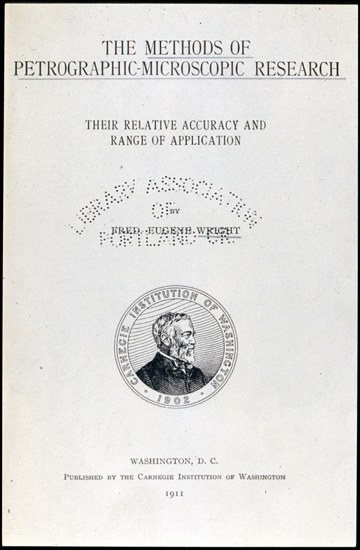
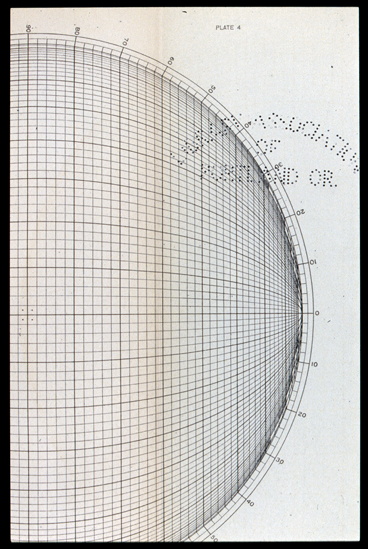
In rare instances, it is possible to tell the book’s owner by the cover. Here, for example, is the front cover of the Imperial Almanac for the year 1855 (from the Gibson Craig sale, 1887), displaying the crest of Napoleon III and Empress Eugenie (Figure 3). The books in Napoleon’s library are leather-bound, and bear the French Royal Arms. Inside (Figure 4), the books have moiré silk end papers, leather hinges, and extensive gold tooling – notice, by the way, the leather Durdans bookplate. The Durdans is a great house in Epsom, near the Downs; it was the home of the Earl of Rosebery (1847—1929), who succeeded Gladstone as Prime Minister.
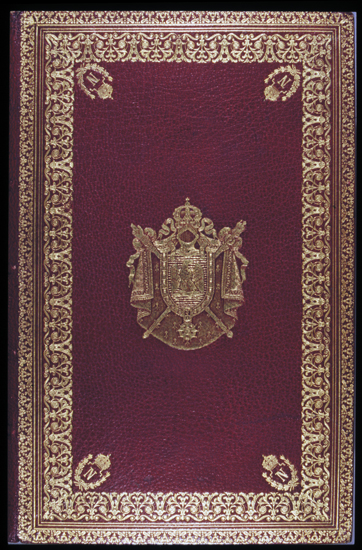

Bookplates are typically paper labels that, in addition to the book-owner’s name, may contain the words “From the library of…” or, the Latin equivalent, “Ex libris” (from/out of the books…). There may also be an admonition or threat, such as “The ungodly borroweth and payeth not again.” Or, from Shakespeare’s Hamlet, “Neither a borrower nor a lender be….” Sir Walter Scott’s bookplate read, “Please return this book; I find that though many of my friends are poor mathematicians, they are nearly all good bookkeepers.” Schoolchildren used to write in their books things such as, “I pity the lake, I pity the brook; I pity the one that takes this book!”
Bookplates originated in Germany; the earliest known, dating from around 1450, belonged to Johannes Knabensberg, called Igler (German, for hedgehog), chaplain to the Schönstett family. His bookplate – a woodcut about 5-1/2” x 7-1/2” – depicts a hedgehog with an inscription which translates as, “Hans Igler that the hedgehog may kiss you.” There is some doubt about the date, because printing from movable type was introduced at about the same time; there would only have been a few printed books available in which to paste bookplates. Manuscript volumes were sufficiently unique to provide their own identification, and family arms were frequently added–especially to Books of Hours. Many sources regard the first bookplate, also German, as that of Brother Hildebrand Brandenburg (Brother Hilprand of Biberach). His bookplate (Figure 5) was in the books he presented to the Carthusian Monastery of Buxheim; it has been dated 1470-1480, and is hand-colored. Bookplates received a big boost in popularity when Albrecht Dürer (1471-1528) started to engrave them; he engraved about twenty, and set the style for bookplates that continues to this day. Here is another early bookplate (Figure 6), from about 1520, which belonged to Jakob Hainrichmann, Prebendary of Augsburg [ a prebendary is a clergyman who receives a subsistence allowance, or stipend (prebend) from the state for officiating and serving in the church]. His bookplate, a woodcut, is also hand-colored. Incidentally, the letters “S.M.C.” in his bookplate stand for the Latin phrase, spes mea christus, Christ My Hope.
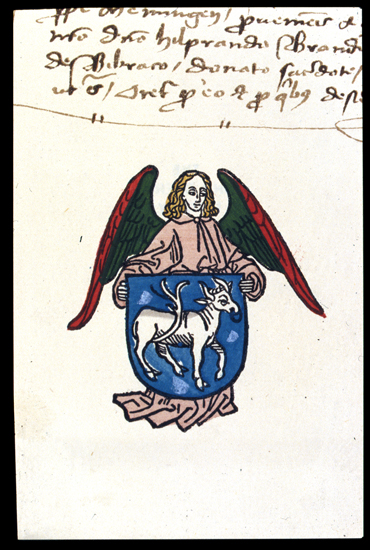
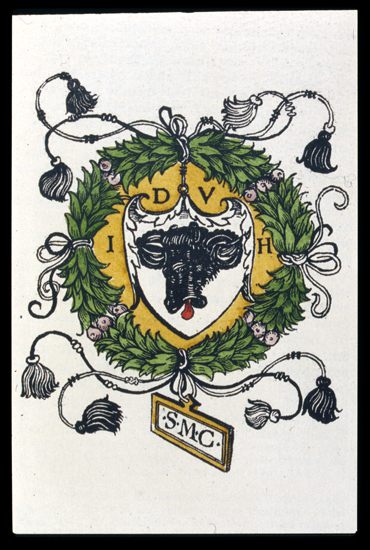
Early in 1891, a few bookplate collectors met in London to establish the Ex Libris Society, and, at the end of the first year, the Society had 300 members, and began publishing its Journal of the Ex Libris Society. By 1897, a list had been compiled of no fewer than 1,500 artists and engravers who had executed bookplates. The first bookplate collector’s society in the United States was founded in Washington, D.C. in 1896 California had its own society, The California Book-Plate Society. In 1972, the American Society of Bookplate Collectors and Designers celebrated its 50th anniversary (their membership directory contained 118 bookplates owned or designed by their members!). There are also bookplate collectors’ societies in Britain, Germany, Austria, and France.
Today, with modern photomechanical methods, laser scanners, and computers, bookplates are quite easily made, and even printed on pre-gummed paper, compared to the expensive copper and steel engravings of the past.
The principal decorative device on bookplates, especially in the past, is some heraldic device or arms, although it may be allegorical or symbolic, indicating the owner’s occupation, profession, hobby, or interest(s). Indeed, many book owners have more than one design of bookplate, and may have a different one for each section of their libraries. Many Sherlockians, for example, have special bookplates made up just for their books on or about Sherlock Holmes. Erotica is still another specialty area; these erotic bookplates usually say Ex Eroticis, or Ex Libris Eroticis (one of the reference books at the end of this article describes and illustrates 109 erotic bookplates from international private collections).
I thought it would be interesting to survey bookplates that depicted microscopes, or microscopical subjects, or that belong(ed) to microscopists. My survey is based on some standard bookplate reference works, listed at the end of this column, on my personal bookplate collection, and, in one case, on information supplied by a fellow collector.
Bookplates of Microscopical Societies
The bookplate of the Bristol Microscopical Society (England) is one of the most delightful of all microscopical bookplates Figure 7). The original of the design was drawn by Ruffle (due to poor printing, this often appears as Buffle), a member of the Quekett Microscopical Club, and was titled “Ye Mikroskopiker’s Arms.” I first saw it in a supplement to the Journal of the Quekett Microscopical Club. The escutcheon (shield on which armorial bearings are displayed) contains a number of items related to microscopy, including a cross-section of the eye, and prisms and lenses at the top; a variety of microscopical test objects in the lower right, including markings on diatoms, and the scale of Podura; at the lower left are a number of microscopic plants and animals, including desmids, diatoms, Vorticella, rotifers, and algae. Above the escutcheon, the crest consists of a microscope in inclined position, described as rampant (this term usually applies to an animal, such as a lion, in profile, rearing on hind legs). To either side of the escutcheon are the supporters (this usually refers to one or two figures, men or animals) which here consist of Daphnia pulex, the water-flea, on the left, and Sida crystallina on the right. At the base, in the banner, is the motto: De minimis non curat lex, the smallest (minutiae) are not the business of the law; i.e., the very smallest things are the concern of the microscopist. This same design has been incorporated into personal bookplates, as we shall see later, in, for example, the bookplate of Charles Bestow.
If you look at the head of this @ the EyePoint column, you will see how this basic design idea was also incorporated here.
W. Watson & Sons, Ltd., the British microscope manufacturers founded in 1837, also adapted this basic design (Figure 8) in their announcement of The Third Annual Exhibition of Microscopes, held in London in 1935 (note the objective, eyepiece, and condenser in the lower right of the escutcheon).
The Manchester Microscopical Society (England) founded in 1880, has, as the principal pictorial on its bookplate (Figure 9), a microscopic object, a budding hydra, rather than a microscope. The book that this appeared in was evidently a 1946 donation to the Society on the part of A.P. Bradshaw.
The State Microscopical Society of Illinois (SMSI) was founded in 1868, and received its State Charter in 1869. Its bookplate Figure 10) bears a photographic image of a splendid microscope made by Walter H. Bullock. The address at the bottom of the bookplate is that of The Chicago Academy of Sciences, the Society’s home for about a hundred years, but no longer; SMSI moved to other quarters about 20 years ago.
The Bulloch microscope depicted is especially appropriate for this Society, because Walter Bulloch had his shop in Chicago, and he was the first known maker of microscopes west of Philadelphia (more can be read about Walter H. Bulloch and his microscopes in Don Padgitt’s A Short History of the Early American Microscopes, Microscope Publications Ltd., Chicago, 1975). The microscope, signed W.H. Bulloch, Chicago, was introduced before 1876, and improved in 1877 and 1879; it is one of the microscopes in the Society’s collection. The photograph of the microscope, and the bookplate, were made in 1968.
Bookplates of Companies
The bookplate of McCrone Associates, an analytical laboratory employing many kinds of microscopes, has as its bookplate a caricature of Dr. Walter C. McCrone, founder of the company, standing tippy-toe on a couple of microscopy and x-ray diffraction books, focusing a camera mounted on a microscope. This bookplate (Figure 11), which is now almost 50 years old, has an interesting story behind it. A book was loaned by McCrone to someone at Chicago’s Newberry Library, and when it was returned, the book contained the caricature, which subsequently was made into the official company bookplate. We will see later that this same design was used for the McCrone Research Institute.
The bookplate of The Ohio Oil Company’s Research Center Library (Figure 12) incorporates a line drawing of a monocular microscope; the outline of the eyepiece is reminiscent of the American Optical Company.
The bookplate of the Sharp and Dohme Library (Figure 13) is in the heraldic style. At the base of the shield are retorts, hypodermic syringes with needles, and representative experimental animals. The crest incorporates a stylized microscope; in the background are reference books, and retort with receiver.
The bookplate of the Chemical Laboratory of Storeys of Lancaster (Figure 14), features a generic microscope in the base of the centrally-placed benzene-ring-like hexagonal design element, together with laboratory equipment (filtration apparatus, graduated cylinder, flask, wash bottle, and tripod with gas burner). The motto indicates that Industry Follows (as a consequence of) Science.
Bookplates of Colleges and Universities
The category of colleges and universities was a bit of a disappointment to me, in that I expected to find many microscopes, but, in fact, found only two. My personal collection of college and university bookplates is quite extensive. In surveying many hundreds of these bookplates, I found only two with microscopes, one from the University of Michigan, and one from the University of Minnesota. Most of the schools use heraldic devices of some kind. I expected M.I.T. or Cal-Tech, or even a science library such as The John Crerar Library to have a microscope on its bookplate, but such was not the case.
One of the University of Michigan bookplates (Figures 15, 16) is a bequest bookplate – that of Ford Messer. The nicely-engraved microscope and skull suggest a biomedical interest.
One of the many University of Minnesota Library bookplates, that honoring Charles August Mann, presented to the Chemistry Library, contains a microscope in symbolic form, along with a Lamp of Learning, a plow, and an artist’s palette indicating a common bond between all of the arts (Figures 17, 18).
Bookplates of Government Laboratories and Research Institutes
The Billings Microscope Collection is housed in Washington D.C. at the Armed Forces Institute of Pathology, which was founded as the Army Medical Museum in 1862. The bookplate (Figures 19, 20) of the Armed Forces Institute of Pathology Library, now quite scarce, depicts a microscope with aperture wheel and bulls-eye lens. Before the adjustable iris diaphragm, one rotated a wheel that had holes of different diameter; changes in the numerical aperture of the condenser to correspond to objective numerical aperture were made by changing hole size – all of which could be viewed at the objective back focal plane. There is a sliding tube coarse focus, and pillar-mounted fine adjustment.
 Figure 20 |
The splendid bookplate of The British Cotton Industry Research Association, founded in 1919, depicts Britannia surrounded by the cotton plant, a loom, and a nicely-rendered microscope (Figure 21).
The bookplate of the McCrone Research Institute (Figure 22) is the same as the one described above for McCrone Associates; only the names at the bottom have been changed.
The bookplate of the National Fish & Wildlife Forensics Laboratory, Morphology Section Library, Ashland, OR (Figures 23, 24) has a graphical microscope whose lower half has been incorporated into the spotted skin of an endangered species.
Bookplates of Individuals
I originally selected the bookplate of Dr. Georg Abelsdorff (Figure 25) because of what I took to be a magnifying glass. However, being curious about the open book, I looked up the name Albert von Graefe. Friedrich Wilhelm Ernst Albrecht von Graefe, who was born in Berlin in 1828, is recognized as the founder of scientific ophthalmology. Dr. Abelsdorff, the owner of this bookplate, was an ophthalmologist. The device that is suggestive of a hand-magnifier is actually an early ophthalmoscope; next to it are instruments for eye surgery, including a cataract knife. The large eye at the top of the bookplate is, then, understandable.
The l (Figure 26) shows a microscope flanking an owl (symbolic of wisdom). The prominent flowers and other floral parts suggest that the owner’s interest lay in botany, or plant genetics.
Percival Bailey’s bookplate (Figure 27) is dominated by nerve cells. This microscopic subject is most appropriate because Dr. Percival Bailey was an American neurosurgeon and psychiatrist. He was born in May, 1892, and died in Illinois in 1973. His preferred working field was the brain. The Library of Health Sciences, Chicago, has a 230-page Catalog of the Percival Bailey Collection of Neurology and Psychiatry. He was the Director of the Illinois State Psychiatric Institute.
Most microscopists will know Arthur L.E. Barron to be the founder, in 1937, and long-time Editor of the journal, The Microscope, and the author of Using The Microscope (Chapman and Hall, 1965); he was the 1998 State Microscopical Society of Illinois August Köhler Award recipient. His bookplate (Figures 28, 29) features an alchemist-like figure with microscope on the table in front of him, chemical apparatus and distillation unit, and reference tomes. On the left side is a printing press, in allusion to his own book publishing efforts; also, his father was in the book exporting business. I am very pleased to be able to relate the story behind this bookplate, as told to me by Arthur Barron in his 1991 letter that accompanied the bookplate.
I quote from his letter, “It was drawn for me by Xavier Collet, a Belgian artist, in 1946. The introduction came by way of the late E.F. Linssen, himself a Belgian National permanently resident in England, his parents being refugees of the first World War. He was a regular contributor to and associated with the editing of The Microscope on the entomological side until 1940, when he was recalled to Belgium on Active Service and then Intelligence.
“It was when he came back to England in 1946 that he told me Collet was accepting commissions and if I cared to have a drawing, he would arrange it. The original is about 6 x 8 ins. and from it I had the printing block made. We had never met, but he asked for my principal interests (microscopy and publishing) and the picture you see was the result. I’ve always liked it and prized it especially for its associations.”
Linssen, whom Barron mentions, wrote thirteen articles for The Microscope between 1937, when the journal was founded, to 1950. Most of his articles were devoted to the evolution of the tilting stage and stereo-photomicrography, but insects, color photomicrography, and Antwerp Microscopists are other topics of his articles.
Edward Bausch (Figure 30), 1854-1944, eldest son of J.J. Bausch (1830-1926) who, with Henry Lomb, founded the Bausch & Lomb Optical Company, has a bookplate prominently featuring a beautifully-executed Bausch & Lomb microscope, with a horizontally-placed large image of the test diatom Pleurosigma angulatum below it (Figure 31). The microscope mirror is, no doubt, tilted toward a white cloud in the northern sky—a favorite microscope illuminant! Edward Bausch authored a book on the microscope, Manipulation of the Microscope (Bausch & Lomb Optical Co., 1885, 1891, 1897, 1901, 1902), but this particular bookplate appears in a presentation copy of Henri van Heurck’s Synopsis des Diatomées de Belgique (1880-1885); van Heurck autographed and presented this copy to Edward Bausch (Figure 32). Van Heurck (Figure 33) is also known through his book on The Microscope (London, 1893), translated into English by Wynne E. Baxter (Figure 34), his book on Photo-Micrography (1894), his A Treatise on the Diatomaceae (1896), and through the microscope made to his specifications by W. Watson and Sons Ltd., known as the “van Heurck” Model (Figure 35).
 Figure 34 |
The bookplate of Francis E. Beddard (Figure 36) contains more macroscopical than microscopical representations. Beddard was prosector (a person who makes dissections for anatomic demonstrations) of the Zoological Society, and one of the members of the “Challenger” expedition. His bookplate, composed by G.R. Halkett, is allegorical of Beddard’s pursuit of Natural History. Dwelling in the tree on the left is a hamadryad (wood nymph) representing the Vegetable Kingdom; she holds a skull, representing Ethnology, in her hand. The various specialty areas of Beddard’s research are represented by the spider, the gull, the flatfish, the trilobite (in the panel at lower left), and various zoophytes. The “Challenger” expedition is suggested by the monk (one of the engraver’s customary devices) in the massively-timbered craft taking soundings. Allegorical bookplates of this kind are often difficult to interpret, and require knowledge of the owner’s life.
The bookplate of Charles H. Bestow (Figure 37) is based directly on “Ye Mikroskopiker’s Arms” described earlier under the Bristol Microscopical Society—and no wonder . . . it IS a beautiful design!
Émile Monnin Chamot, who established and taught Chemical Microscopy at Cornell University, will be best known through one of the several editions of his books, Elementary Chemical Microscopy (1915, 1921) and the Handbook of Chemical Microscopy (1930-1931, 1938-1940). His bookplate does not contain a microscope or a microscopical field of view (Figure 38), but he is too prominent a microscopist to leave out for that reason. The central design element is a rampant griffon (a mythical animal having the head, forepart, and wings of an eagle, and the body, hind legs, and tail of a lion). Quite by accident, I discovered, one day, a variant of this bookplate (Figure 39); In this variant, the hatched letters of his name are filled in solid, as is the griffon’s tongue, and much of the scrollwork.
The bookplate of John Gustav Delly, my own personal bookplate for books on the microscope and microscopical subjects (Figure 40), features a simple microscope, which I also use on my personal stationery. The decision to use this particular microscope came only at the end of a lengthy search. I rejected images of modern microscopes because they lack character. At first I chose to use Watson’s “van Heurck” model because it is so elaborate; then I thought one of the elaborate Powell & Lealand, or Beck, or Smith microscopes would be better. I tried these in mock-up, but they were all too busy. Somehow, I wanted to distill the essence of microscope, much like a fine cognac. I found myself going to simpler and simpler designs, until I found what I was looking for in an inexpensive microscope made by E. Leitz before the 1890s (Figure 41); it is called the Medium Upright Microscope (No. 15). The microscope cannot be inclined, and is furnished with rapid movement coarse focusing produced by sliding the body tube up and down, with fine adjustment achieved via a micrometer screw on the pillar. It was originally supplied with No. 3, 5, 7, and 9 ordinary objectives, and oculars I and III. In 1893 this microscope fully equipped sold for £9.15s.
My second microscopical bookplate (Figure 42) was a gift from a good friend who happened to be in Cologne for Photokina. He found a shop that made custom rubber stamps, and, very thoughtfully, ordered one made for me. Here, the wise old owl peers down the tube of the microscope.
The bookplate of George May Elwood, of Rochester, NY (Figure 43) features a monk surrounded by many books, viewing some interesting specimen with his microscope, perhaps brewer’s yeast, or “the noble rot.”
The bookplate of Frederick C. Freed (Figure 44, 45) clearly indicates that its owner is an obstetrician; next to the wonderful microscope on the desk there is an obstetrical forceps (Bedford’s?), together with anesthesia apparatus. On the left side there is a stork delivering a baby. The medallion above indicates that Freed was a graduate of Jefferson Medical College of Philadelphia; the lower one refers to Bellevue and Allied Hospitals. There is a Bellevue in Ohio, Washington, and New York; this one is likely New York’s Bellevue.
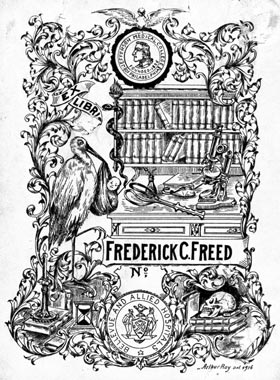 Figure 44 |
The bookplate of Garrett Hardin (Figure 46, 47) is quite intriguing, and can be explained, in part, by knowing that its owner was Professor Emeritus of Biology at the University of California at Santa Barbara. He was trained as an ecologist and microbiologist at the University of Chicago, and at Stanford University. He is perhaps best known for his 1968 essay, The Tragedy of the Common (Science 162), now reprinted in over 100 anthologies; it has to do with ecology, population theory, economics, and political science. In the bookplate, the winged and horned demon-like figure guides the ambiguous ear-trunk-arm in writing on sheaves of paper that turn into the likeness of a tape worm, but as we get farther out, the writing paper segments become, successively, a paramecium, algae, euglenoid forms, planaria, amoebae, . . . and they trail off ever more minute. Interesting.
There is a beautiful interior illustrated in the bookplate of Henry Roughton Hogg (Figures 48,49). The splendid binocular microscope on the table is covered with a bell jar; a beautiful refractor telescope with finder and movable mount is toward the left. There is a spider in the upper left. The Latin inscription along the side, Duce Natura Sequor, can be translated as “pleasant is the pursuit of Nature.” What a very wonderful room this is, with microscope, refractor telescope, and plenty of good books; a very inviting room. Henry Roughton Hogg was an insurance adjustor in Rochester, NY, who was described as “an avid book collector.” His father was a historian in Rochester.
The bookplate with the hand-written name of Thomas L. Jones (Figure 50) is not a custom, personalized bookplate; it is a generic “Science” bookplate. There is another bookplate of the same generic design (Figure 51), signed Cy. L. Wall(?). Still, it’s a rather nice bookplate, with microscope, chemical apparatus, medical apparatus (stethoscope, forceps), and caduceus symbolism.
The bookplate of Dr. Ludwig Kofler (1865-1947) (Figure 52) has suggestions of botany, chemistry and pharmacy – the plant, the distillation apparatus, and the balance, but dates from the 1920s, before his interest in thermomicroscopy (Figure 53). Most readers will know Kofler’s name through the Kofler Hotstage, the Kofler Hotbar, and his numerous books on thermal methods in the microscopical study of pharmaceuticals.
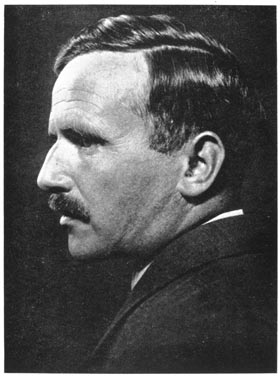 Figure 52 |
The bookplate of Charles Atwood Kofoid (1865-1947) is very interesting (Figure 54); there are planktonic organisms about to be hauled into the plankton net being towed by the research vessel. Kofoid was born in Illinois in 1865, did his undergraduate work at Oberlin College, and received his Ph.D. in Zoology from Harvard in 1894. He was at the University of Michigan for a year, and for five and a half years, he was Superintendent of the Illinois Biological Station, where he wrote numerous articles and books, including the massive The Plankton of the Illinois River 1894-1899. He next went to the University of California at Berkeley where he was a leading member of the faculty for twenty-five years. Look at the upper left end of the bookplate; the campanile (bell tower) seen outside the window is the one on the Berkeley campus of the University of California. Kofoid was one of the leading investigators in protozoology and limnology, and was the developer of what came to be known as the Kofoid Bucket, a device used in the collection of planktonic samples. Here is a color plate from Kofoid’s spectacular 1921 publication on The Free-living Unarmored Dinoflagellata (Figure 55); some of these forms appear in his bookplate, drawn by an artist with the monogram BMC. The associates of Professor Kofoid are said to have been always impressed by the succession of arrivals of packages of books, which did not cease until his death in 1947. A few months before his death, he gave the University more than 40,000 volumes, including many rare works in the history of science and medicine. His obituary appears in Science 106 462-3 (1947).
The bookplate of Professor Dr. Maria Kuhnert-Brandstätter, like that of Dr. Ludwig Kofler, who was her mentor, contains elements symbolic of pharmacognosy – the plants, chemical apparatus, and, of course, the microscope (Figure 56). The initials on the mortar indicate that she composed her own bookplate. She is known worldwide for her book, Thermomicroscopy in the Analysis of Pharmaceuticals (Pergamon Press, 1971), as well as for numerous articles. About fifteen years ago, when she sent me this bookplate, she was already Emeritus, but still going to her office and laboratory at the Institut für Pharmakognosie, University of Innsbruck, Austria. At the Eastern Analytical Symposium (EAS) in 2000, it was announced that Professor Dr. Kuhnert-Brandstätter was the recipient of the New York Microscopical Society’s Ernst Abbe Memorial Award.
The bookplate of Professor Dr. Med. Adolf Loewÿ (Figure 57) suggests a Swiss medical doctor. In addition to a microscope on the laboratory bench, there is a skeleton, chemical apparatus, gas burner, reagent bottles, and instruments. The rat and rabbit are common experimental laboratory animals, and the sheaves of grain suggest an interest in nutrition studies as well.
The bookplate of William DeBerniere Macnider (Figure 58, 59) is dominated by a bookcase/window ledge, with a view to the outside. In addition to the various chemical glassware and reagent bottles below, there is a fine representation of a microscope. A legume borders the bookplate. William Macnider was born in 1881, and died in 1951. He was elected to the National Academy of Sciences in 1938. In 1941 he was the recipient of the Kober Medal awarded by the Association of American Physicians, Chapel Hill, NC. There is a folder of his manuscripts in the University Manuscript Library of the University of North Carolina.
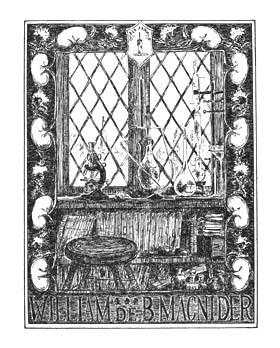 Figure 58 |
The bookplate of William Manning (Figure 60) was composed by his friend, Charles Holme. It is symbolic of Manning’s special interests and pursuits, microscopical, cosmographic, and artistic; there is also indication of his special appointment as “Seer” among the “Odd Volumes.” A rare-book dealer friend of mine told me that he believed that “Seer of Odd Volumes” on Manning’s bookplate refers to an office he may have held in an organization known as, Ye Sette of Odd Volumes, which he believed was located in Boston.
The initials A.M. in the lower right hand corner of Arthur Marsden’s bookplate (Figure 61) indicate that this bookplate was composed by the owner. I do not know who Arthur Marsden was, but the symbolism on the bookplate indicates, possibly, a petroleum chemist. The benzene ring is prominent throughout the bookplate; notice that there are endless strings of benzene rings forming the outside border, coal tar derivatives are emanating from the piece of coal on the left, the very central design figure is hexagonal, and note that around the central benzene ring is a serpent swallowing its own tail – a clear reference to Kekule’s dream of a snake swallowing its own tail, that led him to the structure of benzene. Even the escutcheon bearing the owner’s name is hexagonal-shaped. Power sources are indicated: volcano, the sun, generator and power lines; chemical apparatus also: retort distillation apparatus, balance, filtration set-up. That may also be oil-well drilling equipment. A very nice, and interesting, self-designed bookplate.
The bookplate of F.O. Mosley has a beautifully-engraved (Watson) microscope (Figures 62, 63). On the bench with the microscope is a narrow, top-opening laboratory notebook, pencil, reference books, and a beaker containing three test tubes, with cotton plugs–these may contain agar slants, or they may be genetics experiments with flies. The plants and insect–probably the pollinator–together with the microscope and other equipment suggest that F.O. Mosley was associated with an agricultural experiment station.
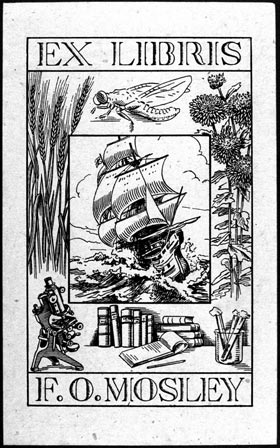 Figure 62 |
The Ethel Katharine Pearce bookplate (Figure 64) was removed from a badly-damaged copy of Mrs. Ward’s book on the microscope. The microscope and charming lamp for illumination in the evening indicate the owner’s interest in microscopy and natural history, in addition to the fact that the bookplate had been mounted in a book on microscopy. This bookplate, composed in 1906 (upper-right corner), indicates in the phrase Solitudinis libri solamen that the owner found solitude in the comfort of books, and the phrase around the hourglass says something about wasting away or pining away – the hour glass reminding us about how little time we all have here.
The intriguing bookplate of Dr. M. Sassi (Figures 65, 66) was mounted in the First Report of the Welcome Research Laboratories at the Gordon Memorial College, Khartoum, the subject of which is the vector insects of Sudan. Dr. Sassi was a specialist in malaria. This 1904 bookplate depicts a research safari in Africa. Of the four African animals at the four corners, the birds’ wings and bodies are incorporated into the design of the flaps of the tent. On the wooden table set up in the tent there is a microscope, laboratory notebook and ink, a crocodilian skull, and several jars of preservative with snakes and other specimens. Outside, a member of the safari is firing a rifle or shotgun at an unknown target, perhaps another study specimen.
Another intriguing bookplate is that of Franz Schubel (Figure 67). In addition to the microscope on the stack of books, there are two insects figured prominently and the owner is clearly quite proud of his Phi Beta Kappa key, and his membership in another Greek-letter society. The bookplate probably belongs to an entomologist.
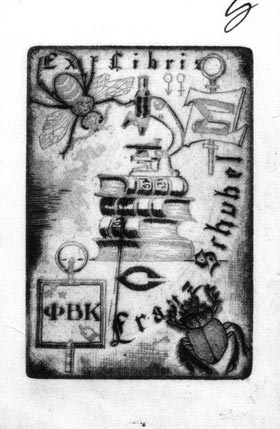 Figure 67 |
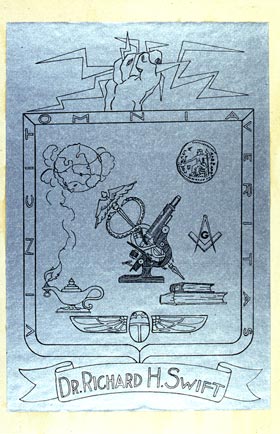 Figure 68 |
The bookplate of Dr. Richard H. Swift of Los Angeles (Figure 68) is mounted in a copy of The Doctor in Court (E.H. Williams, M.D.; Williams & Wilkins, Baltimore, 1929). An inclined microscope is featured centrally in the shield. An ancient Greek coin is also incorporated into the shield. The Latin motto incorporated into the border of the shield, Vincit Omnia Veritas, means Truth Conquers All. Since the book this bookplate was mounted in is a collection of experiences of the Expert Medical Witness, it is probable that the owner was a medical doctor involved in that field, especially since the Appendix in the book refers to Expert Testimony given before the Judge of the Superior Court, Los Angeles County, and the owner was from Los Angeles, as indicated by his embossed stamp on the title page.
The bookplate of Frederick B. Turnbull, composed by “HAW” in 1914, is similar to some other interiors we have seen (Figures 69, 70)–the microscopes to the right on the table set before an outdoor scene; a refractor telescope, with finder, on the left; the open book, with reading glasses; extensive bookshelves left and right; and a sailing vessel in view outdoors. The Latin phrase above, Audaci Favet Fortuna can be translated as Fortune Favors the Bold.
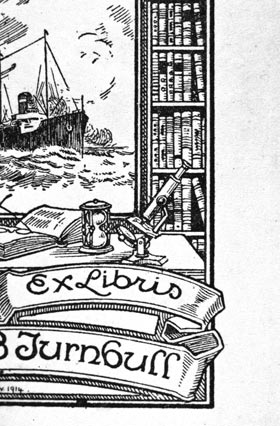 Figure 70 |
The bookplate of F. Noteboom (Figure 71) features a Leeuwenhoek-style microscope in the foreground, as seen from the user’s side; the sample holder is on the reverse side. In the middle ground is a Water-flea of the type reported on by Leeuwenhoek in 1675 and whose detailed notes on it appeared in his famous Letter 18 of 1676, which protozoologists have long regarded as the first paper ever written in their field of study (see Clifford Dobell’s Antony van Leeuwenhoek and His “Little Animals.” Harcourt, Brace and Company, New York, 1932). In the background of Noteboom’s bookplate, there are two desmids, Euastrum sp., with its apical notch (left) and the crescent-shaped Closterium sp. (right).
The bookplate illustrated in Figure 72, which depicts a nude couple on the stage of a jug-handle microscope, is that of Winward Prescott, and it was made for the short story collection of his own library. Prescott’s interest in bookplates was lifelong; he published a bibliography of bookplate literature in 1914, which he revised in 1926. Prescott had numerous personal bookplates to represent different sections of his book collection, which included college bookplates, medical bookplates, Masonic bookplates, Canadian bookplates, Public Library bookplates, etc., etc. Prescott was a 1909 graduate of Harvard, and he gave his collection of bookplates to Houghton Library, where it comprises the largest component of their notable bookplate collection. Houghton Library is the primary repository for Harvard’s rare books and manuscripts. The nude man standing on the microscope stage reading seems remarkably disinterested in his beautiful, nude companion, who is seated on the microscope stage facing away.
The bookplate of Rika Vajda (Figure 73), which falls in the Erotica category, depicts a man expressing obvious delight as he microscopically examines the nude female lying on the stage of his microscope.
The bookplate of Walter Alfred Riley (Figure 74) features a standard non-reclinable monocular microscope. A clue to the owner’s interest lies in the upper right portion of the bookplate, where there is a microscopical field of view showing yeast cells. Walter A. Riley was a director of Morgan’s Brewery in Nottingham, England from 1926. He had a particular interest in the by-products of brewing and malting; that is, the spent wet grain, which was used for cattle food and fertilizer, the spent hops, the spent yeast, and the fermentation gas (carbon dioxide). He wrote a series of articles on these by-products of brewing and malting for Brewing Trade Review, which culminated in his book, Brewery By-Products (London, 1913) that became a standard textbook.
The very interesting Hungarian bookplate of Dr. Antal Miklos (Figure 75) depicts a bearded medical examiner who, with one hand is holding a large stylized monocular microscope while viewing a dead or, more likely, dying body, while with the other hand seeming to hold off Death until he has finished his examination. This bookplate is of particular graphic interest, because on the reverse side it is stamped “Zinkographie.” Zincography is the process of engraving or photoengraving letterpress printing surfaces on zinc.
The bookplate of Josef Melka (Figure 76) prominently depicts a large monocular microscope with circular stage; the user is making notes of his observations. This particular wood engraving bookplate is signed in pencil in the margin at the bottom by the artist, Josef Hodek, Czechoslovakia 1888-1973.
|
Figure 75 |
The bookplate of Prof. Dr. Hubert de Martin (Figure 77) is mounted on the inside front cover of a copy of Otto Lehmann’s Das Kristallisationsmikroskop (Braunschweig, 1910), now in the Donald A. Brooks Collection. An address label on the title page indicates that “Prof. Dr. H. Martin” was a resident of Vienna. His bookplate shows the light path though an inclined binocular microscope, from light source to exit pupil, in side view. A cutout of the cartouche has also been pasted onto the title page.
The bookplate of the Uppingham School Natural Science Society (Figure 78) depicts a beautifully engraved microscope—sans objective—in inclined position. Just behind the microscope in the foreground is a box containing two mounted butterflies. There is physics apparatus on the left, including a Wimshurst electrostatic generator to the left of the microscope, and two Leyden jars on top of the bookcase to collect and store the charge. The view outside of the open window suggests a rural setting. The Uppingham School is, today, a co-educational independent school situated in the small market town of Uppingham in Rutland, England. The school was founded in 1584 by Robert Johnson, the Archdeacon of Leicester. In the 17th, 18th, and 19th centuries, Uppingham remained a small school of 30 to 60 pupils. It became a full boarding school around 1800. The old science building was replaced in 1956 by a new Science Block, which was opened by the Duke of Edinburgh, and it was extended in the 1960’s. In 1989, a new Maths Block, to house mathematics and computing, was opened by Professor Stephen Hawking.
The armorial bookplate bearing the motto “Spes mea in deo” (My hope in God) shown in Figure 79 is that of Freeman Clarke Samuel Roper (1820 – 1896). His bookplate does not bear the image of a microscope, but he is included here because he was the author of an important and comprehensive catalogue of works on the microscope published in 1865. Specifically, his Catalogue of Works on The Microscope and of Those Referring to Microscopical Subjects, in the Library of Freeman C. S. Roper was so complete that even though first printed for private circulation by J. E. Adlard in London in 1865, it has been reprinted several times over the decades. There was a 1900 reprint by J. E. Adlard (London), and then 1970 and 1979 reprints by Nicholas T. Smith, Publisher, Bronxville, New York. Thus, his 102-page catalogue has served as a reference for collectors of microscopical works for almost 150 years. Roper was an English naturalist who was a Fellow of the Linnean Society, a Fellow of the Geological Society, and a Fellow of the Zoological Society. In addition, he was the Honorable Secretary of the Microscopical Society of London, and an Honorable Member of the Microscopical Society of Edinburgh.
In addition to his famous Catalogue…, Roper was the author of Flora of Eastbourne & Cuckmere District, a small octavo (165 pages) published by John Van Voorst in 1875. This volume has a double-page colored folding map, and details individual flowers and their locations. There are also Appendices on Crytogamia of the Cuckmere; Musci, Hepaticae, and Lichens recorded in Eastbourne, and East Sussex plants from Watson’s Topographical Botany, as well as Indices to Latin and English names, Drainage details, Geology, Commons, Marshes, Climate, Limits of Flora, and Rare Plants and their distribution. This book is today available as a Print-on-Demand publication.
Roper died in Eastbourne, England, aged 76.
The bookplate of Edgar S. and Ruth M. Gorrell (Figure 80) is signed by artist Horatio Nelson Poole. The main foreground design elements featured are a classic monocular microscope, accompanied by mortar and pestle, and a conical beaker (left), and an armored helmet sitting on a book (right). The real passion of the owner of this bookplate, however, lies not in these principal design elements, but in the view outside of the window; specifically, the biplane!
Colonel Edgar Staley Gorrell (Figure 81) was one of the Early Birds of Aviation. “Nap” Gorrell was born in Baltimore on February 3, 1891. At the age of thirteen, he entered Baltimore City College, but less than four years later, in February 1908, he entered the U.S. Military Academy at West Point where, amongst other things, he was the broadswords champion of the Academy – thus accounting for the armored helmet on his bookplate. He graduated in 1912, learned to fly at San Diego in 1915, and served with the 1st Aero Squadron during the Mexican expedition (Gorrell is pictured to the right in Figure 82). He was one of the first officer volunteers to be substituted for a sandbag in experimental parachute drops from an airplane! In September 1916, he was sent to Massachusetts Institute of Technology for post-graduate work, from which he received a Master of Science degree in Aeronautical Engineering. He was extremely influential in obtaining appropriations for the Air Service during World War I, and was finally made Chief of Staff of the Air Service, A.E.F. on October 28, 1918, with the rank of Colonel—the Army’s youngest Colonel, not yet 28 years of age. It was he who formulated the plan for the strategic air bombardment of Germany. He resigned from the Army in March, 1920.
In 1921, Gorrell married Miss Ruth Maurice of New York City; her enthusiasm for aviation was said to be scarcely less than his own. Gorrell then became involved with the automobile manufacturing industry and, later, with the mass production of homes. By Pearl Harbor, the plan that Gorrell had come up with for the strategic air bombardment of Germany in 1918 became, twenty years later, the virtual textbook for the Air Corps in World War II.
Edgar Gorrell died in 1945; his ashes were scattered from an Air Force plane in flight over West Point.
The bookplate of Ilmar Laan (Figure 83) was obtained from Estonia. The generic microscope featured on the bookplate is likely symbolic, along with the many books, of “knowledge” or “learning” in general, and not associated with the owner’s special microscopical interest. The chalice or cup, as seen in the upper-left of the bookplate, is often used as a graphic symbol of knowledge. Alexander Pope’s poem, “An Essay on Criticism” (1709) includes a popular couplet which says, “A little learning is a dang’rous thing / Drink deep, or taste not the Pierian Spring.” In Greek mythology, the Pierian Spring of Macedonia was sacred to the Muses; the spring was believed to be a fountain of knowledge that inspired whoever drank from it. The chalice in this bookplate, however, distinctly has a snake associated with it. In some religious homes on December 27th, during the Feast of St. John, the religious superior blesses the wine which is drunk at the meal. This is done to commemorate the legend that once, while at Ephesus, John was given a cup of poisoned wine to drink, but before drinking, John blessed the cup, and the poison departed the cup in the form of a serpent.
A second microscopical bookplate belonging to Ilmar Laan is depicted in Figure 84.
The bookplate of Kazimierza Maronia featured in Figure 85 is a 1961 original woodcut by Polish graphic artist Viktor Langner (1906-1985).
Figure 86 is the bookplate of Doctor Roger du Boistesselin was associated with the Laboratory of Histology, CHU La Pitié-Salpêtrière, Paris, France. He is known for his work in adult humans with non-insulin-dependent diabetes. He was also responsible for suggesting rats as suitable models.
The Salpêtrière was originally a gunpowder factory (“salpêtre” being a constituent of gunpowder), but was converted to a dumping ground for the poor of Paris. It served as a prison for prostitutes, and a holding place for the mentally disabled, criminally insane, epileptics, and the poor; it was also notable for its population of rats.
In 1656, Louis XIV charged the architect Libéral Bruant to build a hospital on the location of the factory, founding the Hospice de la Salpêtrière. The building was expanded in 1684. Today, it is a celebrated teaching hospital—one of the largest in Europe.
Figure 87 is the bookplate of the reknowned French microscope maker A. Nachet. Figure 88 is an enlargement of the bottom third of the bookplate, which depicts a number of optical instruments, including two microscopes, three telescopes, and miscellaneous lenses and prisms, indicative of optical instruments of his manufacture.
This remarkable bookplate is mounted in a book from Nachet’s personal library that now resides in the Donald A. Brooks Collection.The book is Micrographia Nova by Johann Franz Griendel von Ach. (Figure 89). Title translation:
New Micrographs (New Drawings of Small Things) / Or / Newly-Curious / Descriptions [of] / Various small bodies / which / By means of the author’s newly-found extraordinary/unusual / magnifying glasses / become represented extraordinarily large / together with / an appendix of his self-made illustrations / in fourteen copperplates
Figure 90 is the bookplate of Professor Nicola A. Carlone, President of the Società Italiana di Microbiologia Farmaceutica (est. October 2002). Apart from the beautiful microscope on the bookplate, the bacteria behind the nude figure are indicative of her specialty in pharmaceutical microbiology. She is co-editor of the textbook Microbiologia Farmaceutica, Second Edition (Figure 91).
Figure 92 is the bookplate of P.C. Jansen. The microscope depicted is that of Robert Hooke (Figure 93). The bookplate’s owner may be alluding also to the similarity of his name to that of Hans Janssen (also known as Jansen or Martens), along with his son Zacharias, who are generally believed to be the first to create a compound microscope.
The biomedical theme seen in Joep Mous’ woodcut bookplate (Figure 94) includes a microscope, a skull, a hand holding a test tube half-filled with liquid, books, and a saint with a sword (possibilities include St. Paul, St. Michael, St. Maurice, or St. George).
The bookplate shown in Figure 95 is that of W.v.Keulen. The phrase Wees u Zelf is Dutch, meaning Be Yourself. The book titles indicate a wide variety of interests, including art (Van Gogh), poetry (Martinus Nijhoff; 1894-1953), music (Bach), birds (Vogels), natural history (Natuurkunde), and mathematics (Wiskunde).
The microscope is surrounded by additional natural history objects, including botany, crystallography, paleontology, and ichthyology. Even the lower end of the bookplate appears to be a stone with fossil imprints.
The vintage bookplate of Dr. John Kepke (1860-1921) was created by Walter M. Aikman in 1914 (Figure 96). Dr. Kepke appears to have been a general practioner who also delivered babies as indicated by the stork. The phrase surrounding the microscope and library is a quotation from Shakespeare’s Hamlet, Act I, Scene V, in which the ghost of Hamlet’s father asks him to remember him, and Hamlet’s response is:
Remember thee!
Ay, thou poor ghost, whiles memory holds a seat
In this distracted globe. Remember thee!
Yea, from the table of my memory
I’ll wipe away all trivial fond records,
All saws of books, all forms, all pressures past
That youth and observation copied there,
And thy commandment all alone shall live
Within the book and volume of my brain,
Unmixed with baser matter. Yes, by heaven!
Figure 97, the bookplate of Paul Léger, depicts dendritic crystal growth at upper left, a lovely microscope, and a book on organic chemistry.
It is clear from the foregoing examples that there is seemingly no end to the number of bookplates that feature microscopes in a minor or major way. We conclude our treatment of this extraordinarily interesting topic with a selection of microscopical ex-libris, without researching the owners or designers of the bookplates:
|
Figure 116 |
Conclusion
Readers interested in more information about bookplates in general, or advice on how to go about making their own will find two websites, and their indicated links, helpful: www.bookplate.org, and www.bookplatesociety.org. The former site has an illustration of the first known bookplate (circa 1450), that of Johannes Knabensberg–“Igler”–mentioned earlier.
For those interested in making their own bookplate, be on the watch for illustrations that would be appropriate – here are two examples:
Figure 127 is an example of a bookplate in progress as designed by its owner Prof. Alfonso L. Domínguez Cárdenas, a former Zeiss representative, now a school principal in Mexico. The illustration is taken from The Scientist, a Time-Life book in their Life Science Library series. The Latin quotation is from Pliny the Elder, which may be translated as “The least is nowhere more than in the whole of Nature.”
The lending of one’s books is a risky business; one usually loses book and borrower. If the borrower is a friend, lend the book with an appropriate and tastefully-designed personal bookplate pasted inside the front cover; if you do not know the borrower, advise them to,
Go ye rather to them that sell, and buy for yourselves.
Matthew 25:9
It has been great fun surveying bookplates with microscopes; readers knowing of others are invited to help me expand this fascinating topic.
It is a pleasure to acknowledge the following people for the gift of bookplates:
Arthur L.E. Barron, Thomas Joyce, William Kraus, Maria Kuhnert-Brandstätter, Walter C. McCrone, James Solliday, David Stoney, and Reid Zeigler.
Selected References
Allen, Charles Dexter (1896). Ex Libris; Essays of a Collector. Lamson, Wolffe, and Co., London.
Almack, Edward (1904). Bookplates. Methuen & Co., London.
Carver, Clifford, N. (1912). Bookplates of Princeton and Princetonians. Princeton University Press, Princeton, New Jersey.
Castle, Egerton (1894). English Book-Plates; Ancient and Modern. George Bell & Sons, London.
Hamilton, Walter (1896). French Book-Plates. George Bell & Sons, London.
Johnson, Fridolf (1977). A Treasury of Bookplates From the Renaissance to the Present. Dover, New York.
Keenan, James P. (2003). The Art of the Bookplate. Barnes & Noble, New York.
Kronhausen, Phyllis and Eberhard, eds. (1970). Erotic Book Plates. Bell Publishing Co., New York.
Leiningen-Westerburg, Karl Emich Count zu (1901). German Book-Plates; An Illustrated Handbook of German & Austrian Ex Libris. George Bell & Sons, London.
Warnecke, Frederick (1894). Rare Book-Plates (Ex-Libris) of the XVth and XVIth Centuries . . . . H. Grevel & Co., London.




























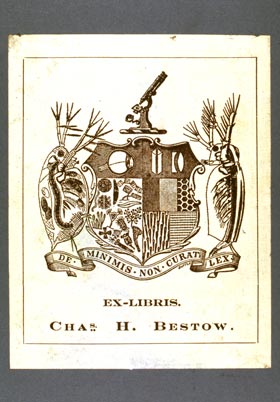


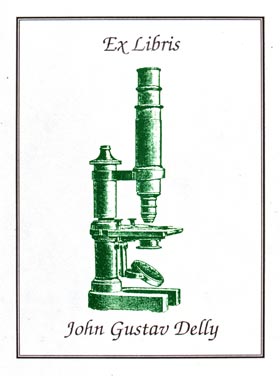

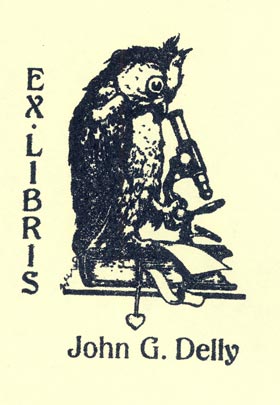
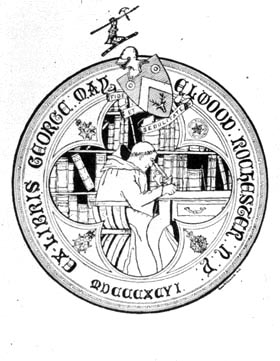
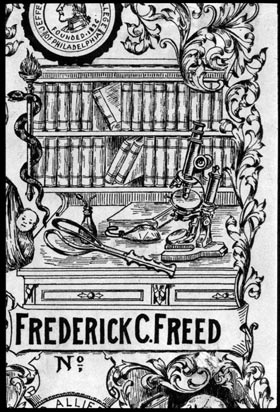
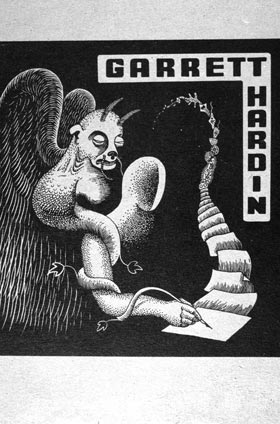
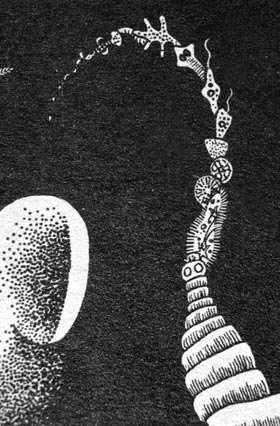
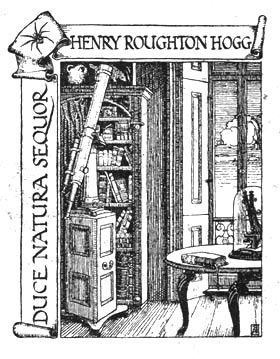

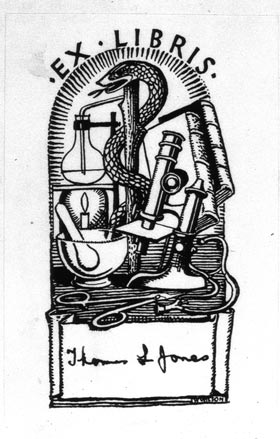
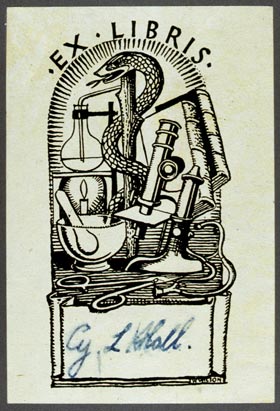
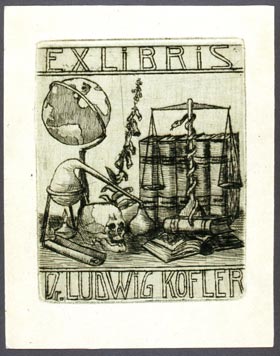
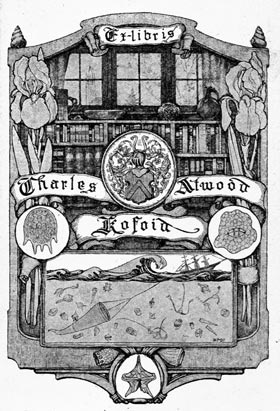


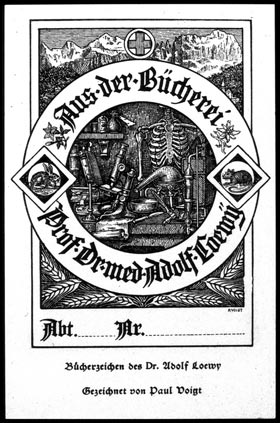
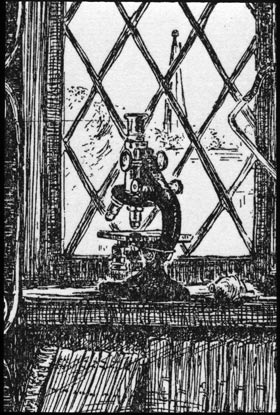

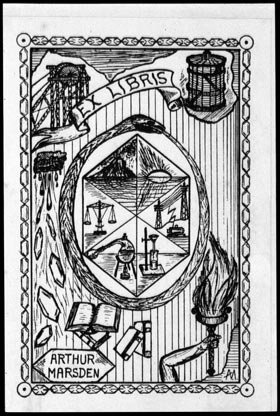
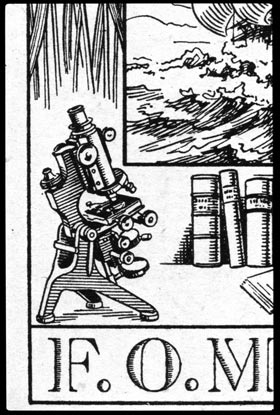
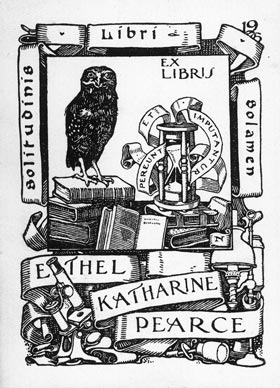

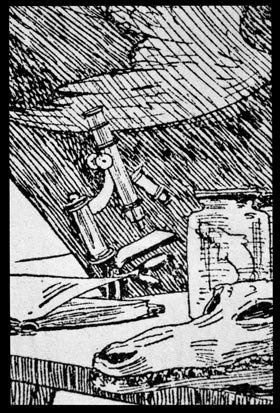
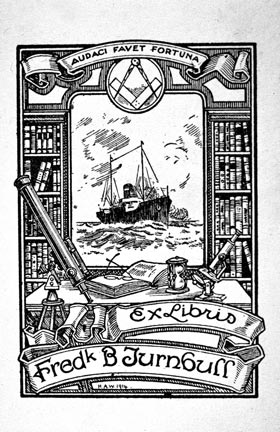
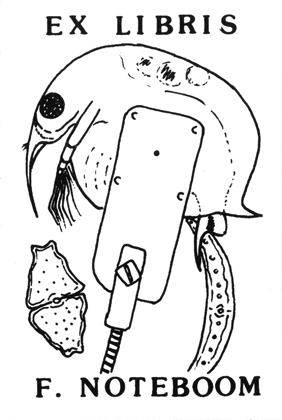

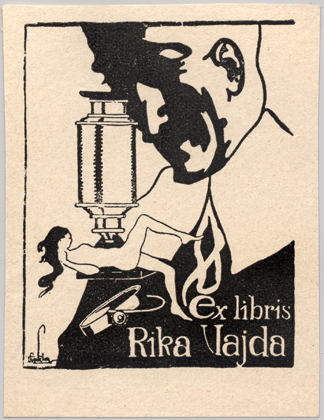

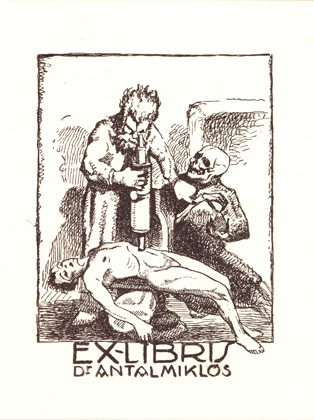
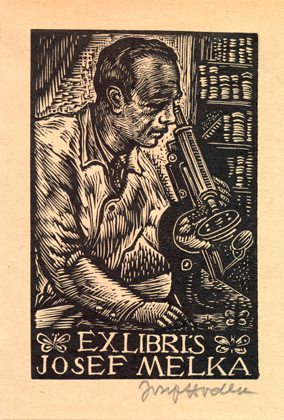
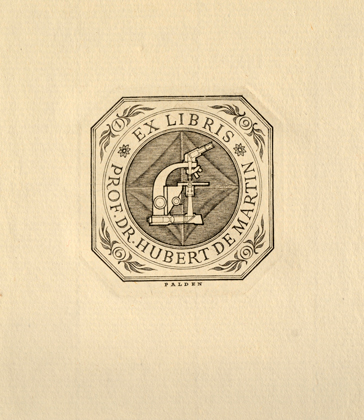
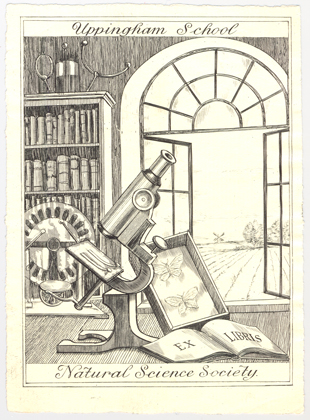
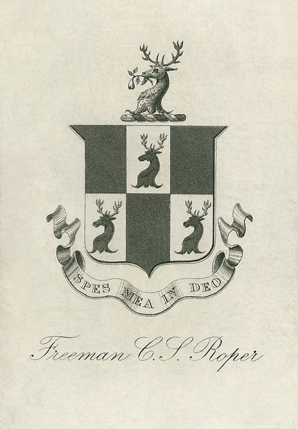
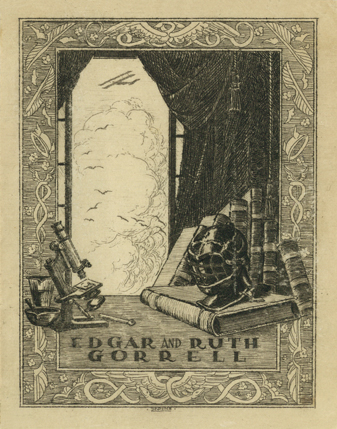
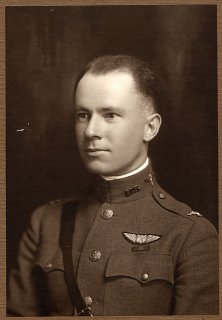
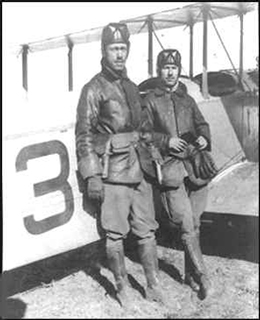
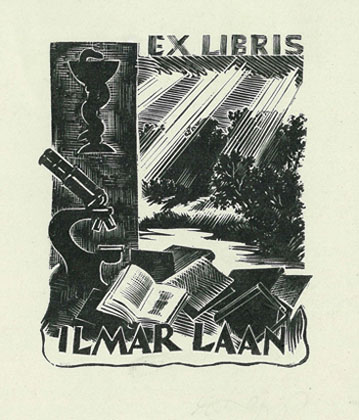

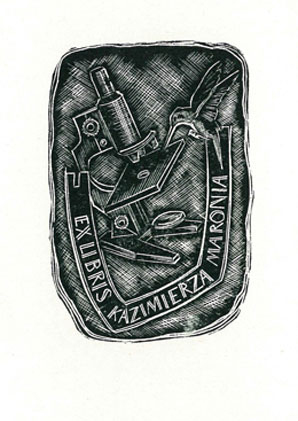
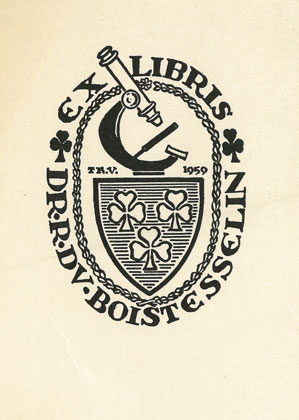
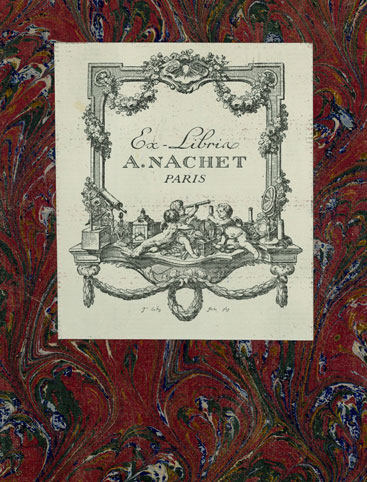
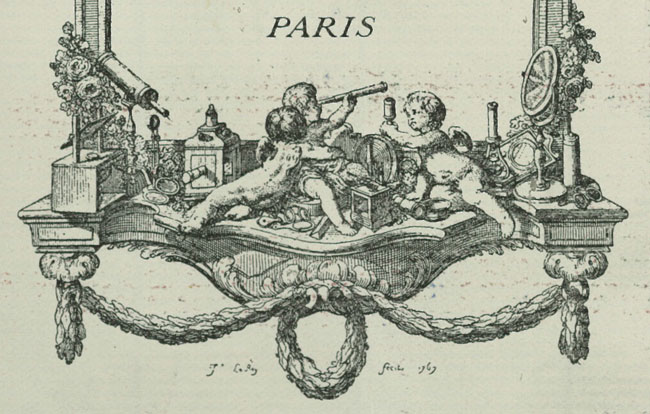
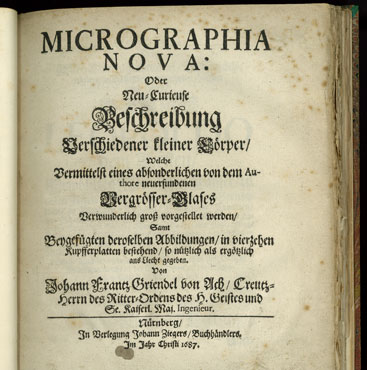

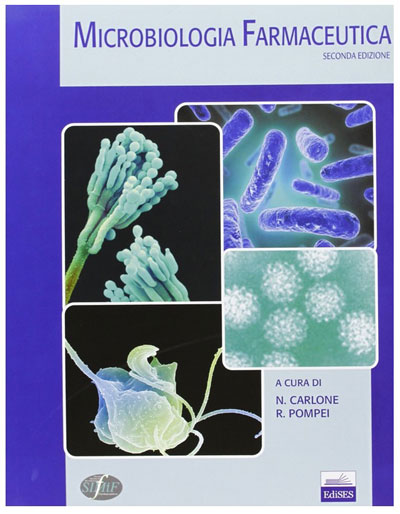
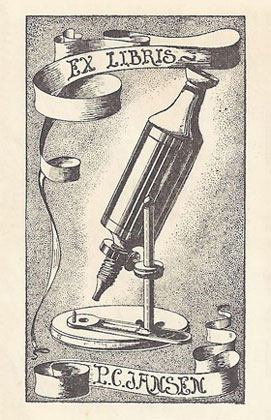

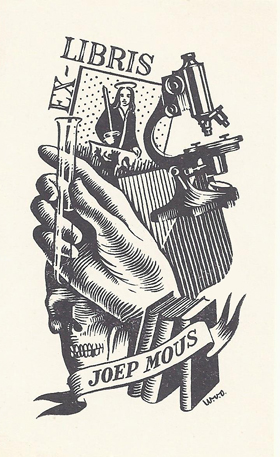
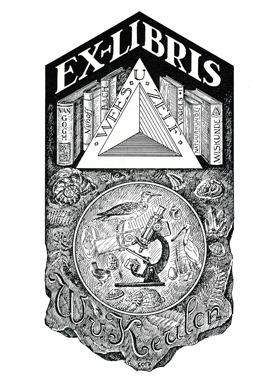
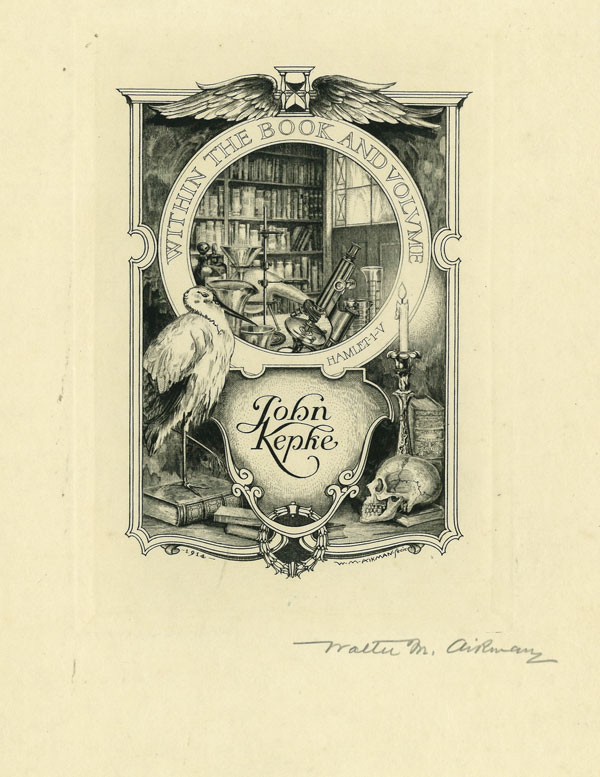
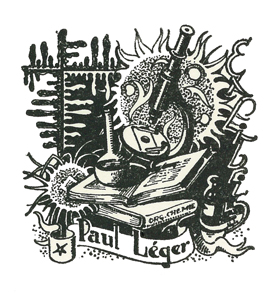
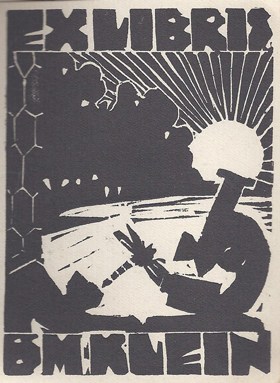
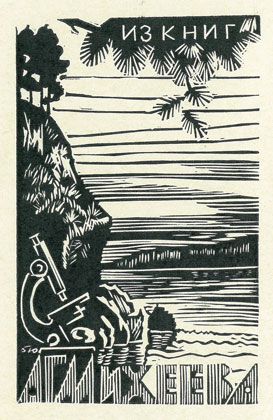
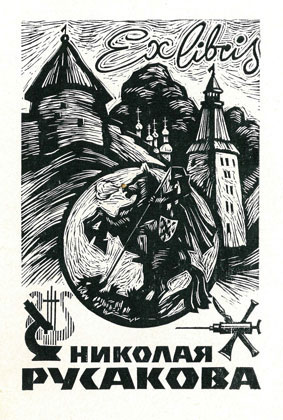
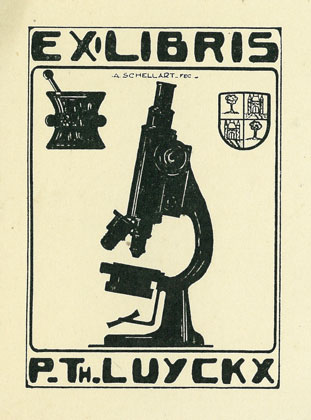
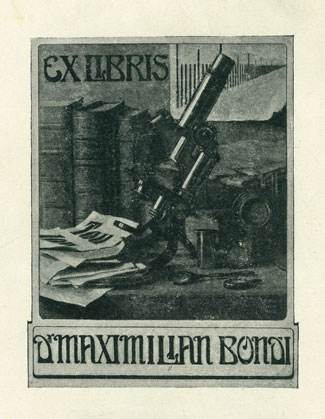
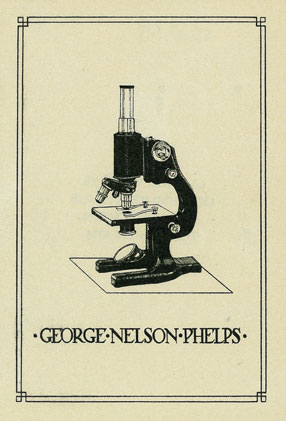
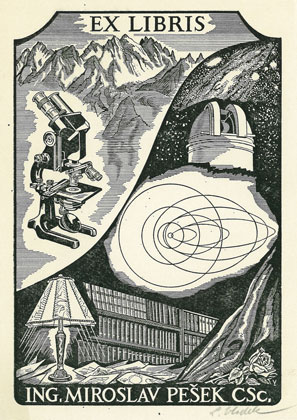
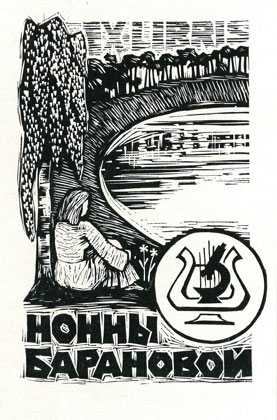
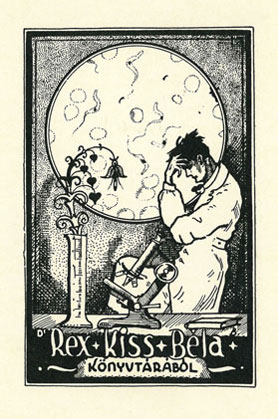

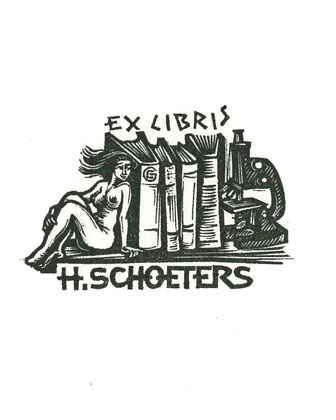
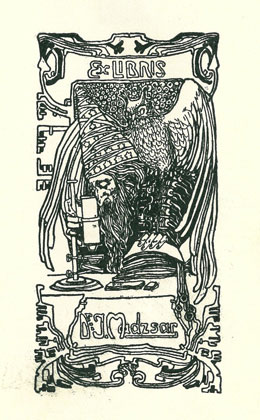
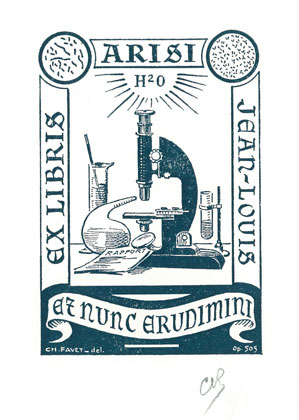
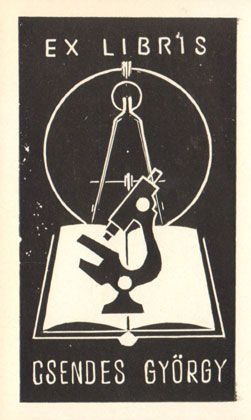
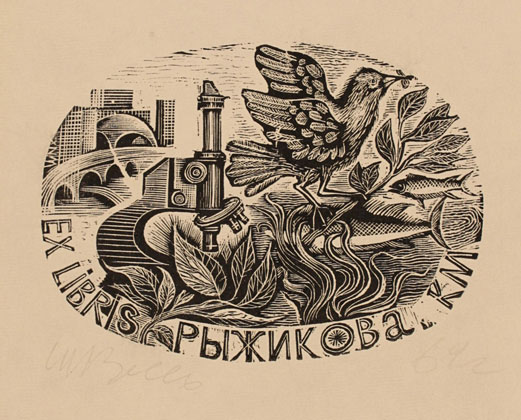

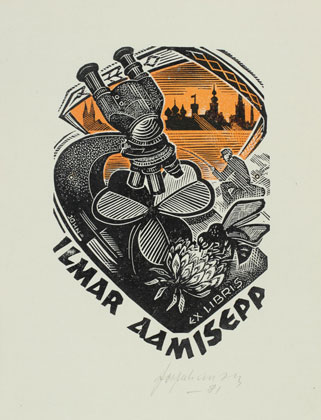
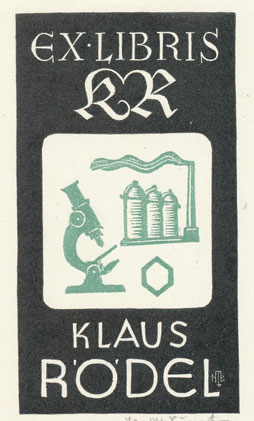
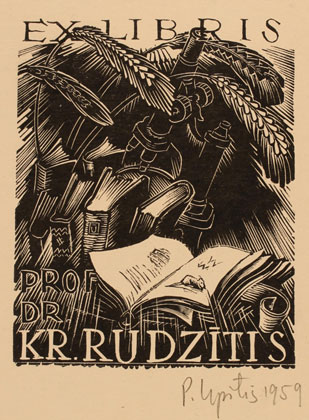
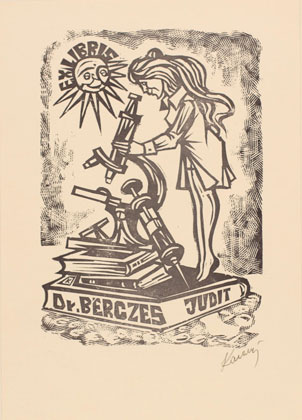


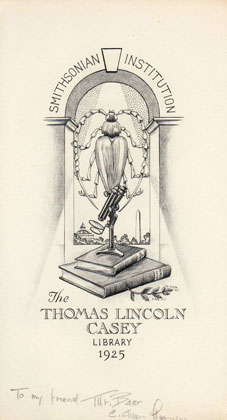
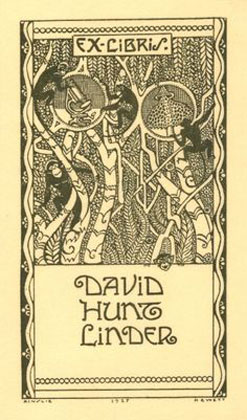
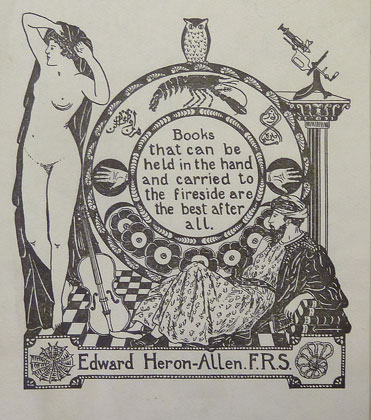
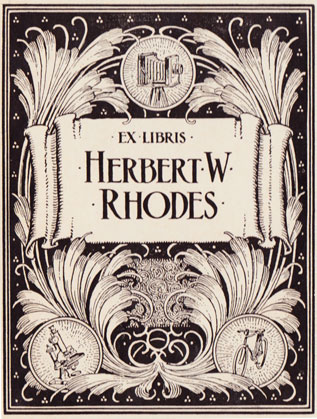
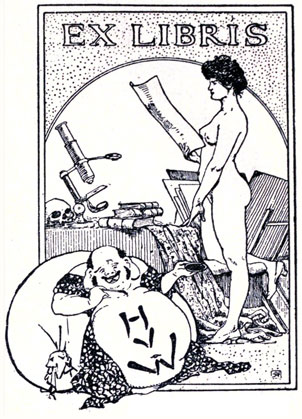
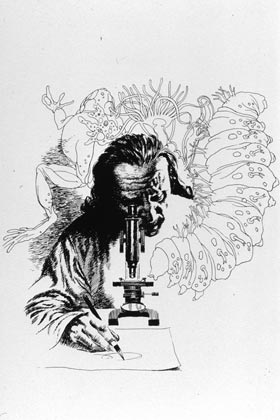
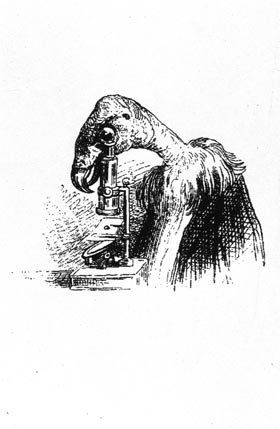
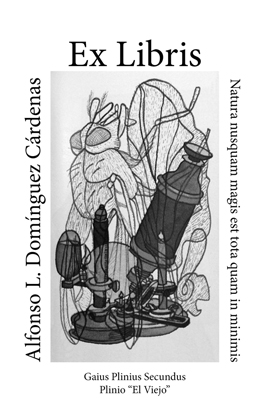
Comments
My Year in 1918
I'm not sure whether this is still being monitored, but if it is I wanted to tell you that I enjoyed this posting a great deal and wrote it on my blog yesterday, at https://myyearin1918.com/2018/04/11/wednesday-miscellany-naked-microscope-bookplate-people/.
Replies
Leslie Bolin
Thank you, Ms. McGeehan. We're glad you enjoyed the article, and learned a bit about Winward Prescott.
add comment